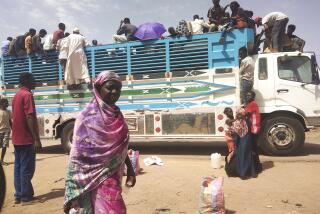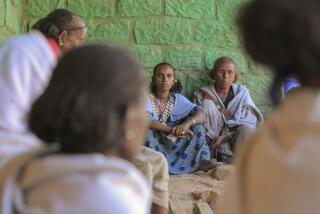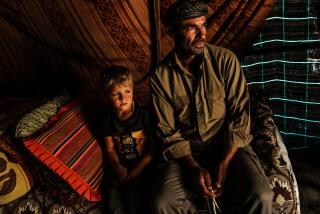Timeless Lifestyle in Peril
- Share via
MANDALGOVI, Mongolia — T.S. Usuhbayar’s worst day came amid a ferocious blizzard early last year that pounded the desolate steppe with gale-force winds and yard-deep snow.
Usuhbayar, 25, stock of generations of nomadic herders, stayed up much of the night. While he tended his prized horses, his wife and mother looked after the sheep and goats. All three were desperately trying to warm the few animals they could fit into their tiny, portable home here in the Gobi desert.
But a staggering toll awaited in the white wilderness at dawn: About four dozen of the horses, two cows and at least half a dozen sheep lay still, frozen to death.
The family cried and cried. But the “Great Zud” was unrelenting, and by the end of the long winter, it had spared just 30 of the family’s 200 animals.
For the last two years, a vicious cycle of summer droughts followed by winters of deep snow and heavy ice--conditions known collectively here as the Zud--has devastated Mongolia. Thousands have lost most or all of their livestock. Stacks of dozens, even hundreds, of frozen animals have become fixtures outside herders’ homes, piled high like so much wood.
Even the twin humps of the stalwart Bactrian camels have gone flaccid, devoid of the fat stocks that keep them upright.
And now, this vast country, one of the last remaining horse-based cultures, is hunkering down for another cruel winter. At risk: the ancient way of life of the nomadic herders, who make up half of the landlocked nation’s 2.6 million people.
Last year alone, 7,400 herders lost all their livestock, while 13,000 lost half.
There is nothing more vital to Mongolia’s nomadic herders than their animals. Sheep, goats, horses and sometimes cattle and camels provide food, security and fuel: fermented mare’s milk to drink, mutton to eat, wool and lucrative cashmere to sell, and dung to fuel stoves.
Under normal conditions, it is a remarkably self-sufficient life. One can travel for hours by jeep on deep-rutted dirt roads without seeing a soul. Suddenly, a shepherd tending his small flock comes into view, a tiny figure amid the open plains. A traditional felt tunic skims the tops of his sturdy black boots, a colorful orange sash circles his hips, a felt hat is perched on his head. Not far away is his ger--a round, one-room house resembling a quilted igloo.
Mongolians have a saying: “Thanks to our livestock, we’re fed and clothed.” But without their animals, says P. Gankhuyag of the country’s Agriculture Ministry, “the herders are helpless.”
With no landownership or fences beyond urban areas, the nomads follow their herds in search of good pasture. Although much of the country is desert, with fierce winds kicking up dust and sand, wild grasses usually manage to grow tall and mountains abound, pinched at the top as if mounded out of Play-doh.
But the animals couldn’t gain enough fat in summer on withered fields to sustain them through winters of subzero temperatures, when the herds typically lose 40% of their body weight. Then, the Zud’s heavy snowfalls and ice prevented the animals from getting to the grasses below.
It is remarkable that only about three dozen shepherds have perished, most lost in blizzards while searching for their herds. They have a seemingly innate sense of direction--navigating by stars or the shape of a hill’s crest.
A Constant Search for Better Pastures
The nomads typically pull up stakes three times a year, though they usually stay within a 25-square-mile area. Their cozy gers are relatively easy to dismantle, formed of a center beam, several poles that radiate like an umbrella’s spokes and collapsible wooden latticework “walls” lined with felt.
But the Zud has driven herders to pick up house as often as twice a week, searching for better pastures. Many have migrated to other provinces--putting stress not only on pastures and water sources but on social services such as boarding schools, where children spend the winters.
Last year, nearly 8,000 people in 18 provinces moved to other provinces with nearly 7 million livestock. “They don’t care about themselves; they only care about their livestock, which is why they move every three or four days,” says Chimeddorj Togoo, deputy chief of the country’s Emergency Commission.
The overgrazing causes erosion and depletion, and thousands of wells have fallen into disrepair in recent years. The Zud has driven many to abandon herding and move into the city to look for work. The population of the capital, Ulan Bator, swelled from half a million four years ago to at least 800,000 or, by some estimates, well over a million. Unemployment hovers near double digits, and soaring numbers of street children survive in sewers.
The government--which made a peaceful transition 10 years ago from communism to democracy--is doing its best to help, relief agencies say. But with few opportunities beyond light industry to attract foreign investors, it can’t afford to do as much as necessary. One-third of school budgets go for winter heating.
The Agriculture Ministry has anted up money for 45 pounds of grass for each head of livestock--enough for about two weeks. Even moving the hay across this country twice the size of Texas is daunting.
A recent journey of about 150 miles south from the capital to Mandalgovi took seven hours in clear conditions; the same journey could take two to three days in snow.
In Province, Herders Face Extreme Poverty
Aside from planes, Mongolia’s only other transport to the outside world is a single railroad that crosses from Russia’s Siberia through Mongolia to China.
Here in Middle Gobi province, more than two-thirds of the 10,000 herding families face extreme poverty. By spring 2000, 35% of the province’s 2.1 million head of livestock had perished. Less than one-third of the expected 600,000 animals were born that season. This year, an additional 4.3% of the province’s livestock has died.
Now about 200,000 head of livestock from 10 counties farther south are munching on the grasses here as well. The new residents include the once-prosperous, and now nearly destitute, Owunchuluun family, which has lost 350 animals.
T. Owunchuluun, the mother of five children between 7 and 17, is quiet, mournful, her eyes welling with tears as she describes how the animals couldn’t get enough to eat in summer and were too weak to survive the winter.
She now lives in town amid a cluster of gers, each with its own small yard and outhouse, surrounded by a fence. Her husband stays with their 30 surviving animals about 15 miles outside town, once a week riding his motorbike home to visit while their eldest son tends the herd. She longs for her old life.
Their future looks bleak.
“For a family of seven, less than 40 animals is nothing,” says S. Ganzorig, a village chief in Saintsagaan County. “They’ll need five to 10 animals just to provide their food in the winter, and things will get worse.”
The Zud has also killed most of the province’s horses, an economic as well as deeply psychological blow. Horses not only provide transportation and milk but are considered a measure of a man’s wealth. They are so revered here that the Mongolian language has 300 words to describe them, most having to do with coloring: a bolt has a white spot on its forehead, for example, while a longor has a light auburn tone.
The United Nations and about 80 aid groups have come to Mongolia’s assistance with food, grants and loans.
“It’s difficult to imagine what this place would be like without international aid,” says B. Andrei, Saintsagaan’s deputy governor. He is both grateful for and disturbed by the assistance. “Instead of being workers, the [herders] become beggars. Wiser people would say it’s better to provide them with livestock than food, so they can make their own living.”
Some programs have done exactly that. World Vision taught 600 families in the province to grow vegetables. And the World Bank has provided loans for more than 500 families in Middle Gobi alone, to purchase 25,000 animals.
For Usuhbayar, the man whose family lost most of its animals, the loans are manna from heaven.
He, his wife and 3-year-old daughter live with his mother alongside his brother’s ger, about a 15-minute drive from Mandalgovi.
Usuhbayar’s wife, J. Bolormaa, clad in a royal-blue silk tunic, serves sweet crackers and bowls of fermented mare’s milk to visitors who arrive unannounced one afternoon.
Usuhbayar pulls out some Mongolian vodka and small silver shot glasses, while his wife stirs a pot of mutton soup on the stove. The winter diet: all mutton, all the time. The pungent smell seems to permeate everything, even the paper money.
Portable Home Includes a Black-and-White TV
For a portable house with nothing but dirt in sight, it is a remarkably comfortable setup. A small round opening at the top of the ger lets out the smoke from the stove while letting in sunlight. Above it soars an incredibly blue sky. Red rugs hang from the interior, and vinyl covers the floor. Old tin milk cans hold mare’s milk and other staples. A bed lines each side of the ger. A few family pictures are stocked on a small wooden chest. The space is slightly smaller than a two-car garage.
The small door, painted bright blue, faces south, the least windy direction. The support poles are painted orange, symbolizing the sun.
A lightbulb hangs from the ceiling, and a black-and-white television sits on a chest, powered by the family’s wind-powered generator.
To qualify for the Word Bank loan, Usuhbayar had to prove he was a hard worker with access to a well. No repayments are required the first two years, and the rest is payable during the next three. All told, they’ll pay back about $1,150--due in animals or cash.
His plan is not to slaughter or sell any of the “loaned” animals, only new births. That way, he figures, they can double the herd by the end of the five-year period--provided there’s no Zud. “It all depends on whether there is a natural disaster and whether we work hard,” he says.
So far, so good: Twenty young were born this year, all healthy. The family has stashed away enough hay for half the winter.
Usuhbayar is clearly smart and well seasoned. Like most Mongolians, he graduated from junior high school and can read and write the Cyrillic characters of the Mongolian language.
At least as important, he says, is the herding know-how learned from his father and grandfather, though they belonged to the collectives established under communism. When the system was privatized in 1996, some of those who were given livestock had never herded before. They are among those believed to be worst hit by the Zud.
“A herder whose ancestors were herders sucks all the herding knowledge with his mother’s milk,” Usuhbayar says. “If the wind blows from the southwest,” he notes, “I would manage my animals a certain way.”
Then he asks an American visitor how livestock are tended in the U.S. “Are they raised by nomads?”
Asked if they ever remember conditions as bad, his mother, D. Zagd, 68, says the Great Zud of 1944 was worse. “The Zud covered nearly all the world in the Year of the Monkey, just before World War II ended,” she says. “Only one cow in the entire valley remained, while this year, every family has three or four animals left.”
Her son muses: “The Zud--it happens sometimes. It’s survival. It’s our karma.”
Could he ever imagine himself doing anything else--or see himself moving into town, or even the big city of Ulan Bator? Usuhbayar doesn’t hesitate a second.
“Not even if Buddha himself invited me.”
More to Read
Sign up for Essential California
The most important California stories and recommendations in your inbox every morning.
You may occasionally receive promotional content from the Los Angeles Times.













